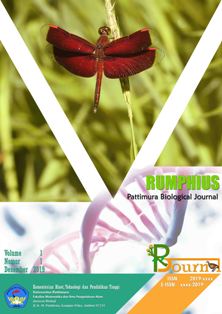INTEGRATION OF PROJECT BASED LEARNING (PjBL) AND PICTURE AND PICTURE (PaP) LEARNING MODELS ON PROCESS SKILLS, CRITICAL THINKING AND LEARNING OUTCOMES OF CLASS X IPA STUDENTS AT SMA MUHAMADIYAH MASOHI AND SMA NEGERI 15 CENTRAL MALUKU
Abstract
Project based learning (PjBL) is a learning model that uses problems as a first step in collecting and integrating new knowledge based on real experience, Picture and picture (PaP) is a model using media in the form of images so that students are more focused and learning conditions pleasant. Integration between these two learning models to complement each other's strengths and cover each other's weaknesses so that what is expected after the learning process can be achieved, Integration of project based learning (PjBL) and Picture and Picture (PaP) learning models as independent variables, process skills, critical thinking and learning outcomes as the dependent variable. The aim of the study was to determine the effect of the integration of Project Based Learning (PjBL) and Picture and Picture (PaP) learning models on the ability of processing skills, critical thinking and learning outcomes of class X IPA SMA Muhamadiyah Masohi and SMA Negeri 15 Maluku Tengah. The research method is Quasi Experiment with 2 control classes (lecture method), 2 experimental classes (PjBL & PaP integration). The results showed that there was an increase in learning outcomes (87.08), process skills (85.14) critical thinking (84.20) students of class X IPA SMAN 15 Maluku Tengah, increased learning outcomes (83.10), process skills (83 .93), critical thinking (80.00) class X IPA SMA Muhamadiyah Masohi. The LSD test shows that there is an effect of integration of PjBL & PaP on process skills with critical thinking (0.020) Class X IPA 2 SMA Muhamadiyah Masohi, there is an effect of integration of PjBL & PaP on process skills with learning outcomes (0.014), and on learning outcomes with critical thinking (0.030). The conclusion is that there is an influence of the integration of Project Based Learning (PjBL) and Picture and Picture (PaP) learning models on the ability of processing skills, critical thinking and learning outcomes of class X IPA SMA Muhamadiyah Masohi and SMA Negeri 15 Maluku Tengah.
Downloads
References
Fakhrizal, T., & Hasanah. U. 2020. Efforts to improve students' critical thinking skills in biology subjects through the application of project based learning learning models in class X SMA Negeri 1 Kluet Jawa Tengah. Journal of Biotics. 8 (2): 200-2017.
Fatmawati, B. 2013. Assessing students' science process skills through direct observation learning methods. Proceedings of the Biology Education Conference. 10 (1). Biology Study Program–STKIP Hamzanwari. Selong.
Hamidah, I., & Citra, Y. S. 2021. The effectiveness of the project-based learning (pjbl) learning model on student interests and learning outcomes. Journal of Biology and Science Education. 4 (2): 20-27.
Jagatara, W.M.I., Adnyana, B.P., Widiyanti, M.P.L.N. 2014. Influence project-based learning model (project-based earning) on biology learning outcomes in terms of learning styles of high school students. Science Study Program. 4 (2): 3540.
Murni, E. 2016. Application of the project-based learning method in learning. Indonesian Christian University.
Norhasanah. 2018. Critical thinking ability of high school students in learning biology. Journal of Biology Learning. 5 (1): 23-29.
Palennari, M. 2016. The influence of problem-based learning and cooperative jigsaw integration learning on critical thinking skills. Journal of Educational Sciences (JIP) State University of Malang. 22 (1): 32-29.
Prasetyo, E., Widyawati, S., Masyikur, R., Putra, G. F. 2018. The effect of picture and picture learning (pap) on mathematics learning outcomes in terms of spatial intelligence. Beta Journal of Tadris Mathematics.11 (1): 50-61.
Riyadi, S. A. 2019. Implementation of the project-based learning model in biology learning on communicative, collaborative, critical thinking, and creative skills of high school students. Science Education Study Program. Indonesia.
Rosyida, F., Zubaidah, S., Mahanal, S. 2016. Empowering critical thinking skills with the remap temps (reading concept map timed pair share) learning model. Proceedings of Biology Education Conference. 13 (1): 209-214. XIII National Seminar on Biology Education FKIP State University of Malang.
Sainab. 2022. The effect of picture and picture learning models on learning motivation and biology retention of Students Class X at SMA Negeri 2 Majene. Oryza Journal of Biology Education. 11 (1):12-19.
Santiawati, S. 2021. Integration of jigsaw-type inquiry and cooperative learning models for increasing student understanding and participation. Pedagogia Scientific Journal of Education. 13 (1): 23-28.
Sukmawijaya, Y., Suhendar., Juhanda, A. 2019. The effect of the steam-pjbl learning model on students' creative thinking ability in environmental pollution material. Journal of BioEdUIN. 9 (2):12-19.
Susantini E. 2021. Biology learning ideas that can train higher-order thinking skills (HOTs). Proceedings (National Seminar on Biology and Science Education). Department of Biology. Surabaya
Triani, T., Copriady, J., Rasmiwetti, R. 2021. Integration of NHT learning strategies in the PBL learning model to motivate and improve student learning outcomes. Journal of Chemistry Education. 2 (2): 64-72.
Utami, R. T. 2018. Application of the project-based learning learning model to students' science process skills in physics learning in class XI IPA SMA N 1 Lareh Sago Halaban. Physics Study Program, Faculty of Tarbiyah and Teacher Training, IAIN Batusangkar. Sumatra Indonesia.
Wicaksono, D. 2019. The influence of the project-based learning learning model on the activeness and cognitive learning outcomes of class XI students SMK N 2 Yogyakarta. Yogyakarta State University. Indonesia.
Zaini, M., Capsule., Rezeki, A. 2017. Learning outcomes and critical thinking skills of high school students in biology learning using the inquiry model. Journal of Biology Education. 11 (1): 17-22.
Authors who propose a manuscript and have it approved for publication know that the manuscript will be registered and become part of the RPBJ. Authors and readers understand that this journal is open and all its contents can be accessed freely, provided that RPBJ is still listed as the source of information. The hope is that this journal can become a vehicle for exchange and scientific knowledge for society and the scientific community, especially in the field of Biology and other branches of science.









